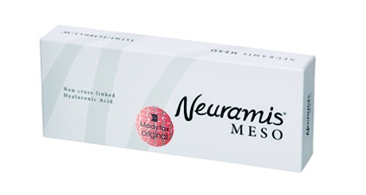It is not easy for a novice specialist who is just starting to master the methods of correcting age-related changes in the face to understand the features of injectable preparations. Often, the nature of the use of – for moisturizing, stimulating regeneration or contouring procedures. An ideal option for any cosmetologist, regardless of his level of professionalism – this is an opportunity to solve all the problems of face correction with the help of drugs of one line. This opportunity is provided by Neuramis preparations from Emettm.
How does hyaluronic acid work, and which drug should I choose for different tasks?
Hyaluronic acid – a key component of preparations for many injection procedures associated with the correction of age-related changes. It is the main component of mesococktails, bioreparants and biorevitalizants, fillers based on modified hyaluronic acid. As part of meso-cocktails, I most often use hyaluronic acid of low molecular weight, unmodified, which allows it to quickly biodegrade in tissues and have a moisturizing effect, but, as a rule, this method requires a large number of procedures, and the effect does not always last long. The introduction of high molecular weight hyaluronic acid (more than 1000 kDa) as part of a biorevitalizant into the dermis will be more physiological, since in a healthy person & nbsp; the average length of the HA molecule fluctuates within 2000 kDa. What is the purpose of its use in this format? If we summarize the main function of hyaluronic acid in the skin, then this is participation in the formation of an intercellular tissue framework, cell proliferation and migration, cell signaling about the health of an organ or tissue. If preparations, in addition to hyaluronic acid, contain other components, then it acts as their most physiological transporter to the skin.
High molecular weight hyaluronic acid revitalizes the skin, normalizes homeostasis, activates cellular metabolic processes. Therefore, its injection is called biorevitalization.

There is another type of high molecular weight HA – fillers. Cosmetic companies for the production of fillers use high molecular weight HA, and to reduce the rate of degradation and increase its density, cross-linked molecules are used with the help of molecules of bunanediol ether – BDDE or divinyl sulfone DVS. For fillers, the degree of crosslinking is very important – expressed as a percentage of the amount of cross-linked disaccharides and varies from 0.1 to 15%. In such preparations, HA biodegrades much more slowly (from 4 months to one and a half years) and performs completely different functions. Fillers are designed to physiologically replenish the lost volumes of deep facial fat packs, or form the skeleton of the dermis, correcting the appearing & nbsp; wrinkles, as well as various other types of corrections, called injection & nbsp; contour plastic. Injectable preparations based on unstabilized and stabilized hyaluronic acid are included in the Neuramis line from Emettm. Neuramis Meso biorevitalizant based on non-stabilized hyaluronic acid perfectly restores the hydrobalance of the skin, increases its elasticity, and visibly improves texture, which is noted by patients after the first procedure.
What is the significance of prolonged biorevitalization, and which drug should be chosen for simultaneous biorevitalization and wrinkle correction?

The method of prolonged biorevitalization occupies a special place among anti-aging procedures. For its implementation, injection of the drug with & nbsp; hyaluronic acid, perfectly purified and having a high molecular weight, while & nbsp; by using a small number of crosslinks, it is provided slowing down the rate of its biodegradation in the dermis, thus the effect of prologated birevitalization is observed - & nbsp; prolonged activation process dermal fibroblasts. It is their activity that ensures the restoration of the intercellular substance and & nbsp; prolonged effect of the procedure.

Features of prolonged biorevitalization:
• over time, the effect of the procedure increases;
• small doses of the intradermally administered drug stimulate the work of fibroblasts;
• in tissues, metabolic processes are optimized and the physiological environment is restored, slowing down the aging process of the skin.
Neuramis Light Lidocaine is a high molecular weight hyaluronic acid preparation with a low degree of binding, which is a filler with a low density, designed to correct fine wrinkles, long-term restoration of skin hydrobalance, improve structure and skin elasticity. When administered, it requires good skills from a doctor and when filling wrinkles, it should not be injected with the formation of papules, only dermal microinjections, which ensures the replacement of the lost dermis framework and guarantees prolonged biorevitalization.
Biorevitalization and contouring procedures are quite compatible. The doctor determines the procedure for their implementation, depending on the condition of the patient's skin and the upcoming volume of correction. In some cases, it is preferable to start with improving skin health through a course of biorevitalization. In other – such a course helps to improve the results of contouring.
The Neuramis line offers products with high-quality, perfectly purified hyaluronic acid, but its different density, which allows solving any problems of anti-aging correction.

Line of fillers Neuramis refers to monophasic fillers based on FDA approved hyaluronic acid. All preparations of the Neuramis (ed. - submitted by Emettm) have the same concentration of hyaluronic acid, which is 20 mg / ml and are represented by five positions that differ from each other in the degree of stabilization of hyaluronic acid molecules. In Neuramis fillers, hyaluronic acid is stabilized and purified using the unique SHAPE technology patented by Medytox. The essence of the technology is a two-stage process of cross-linking - individual for each filler, as well as in the two-stage process of cleaning ready-made fillers from unused stabilizer and unpaired bonds of hyaluronic acid. This approach ensures the absence of swelling during and after the procedure, good viscosity and elasticity of the filler, which allows the gels to be evenly and naturally distributed in various facial tissues, guaranteeing a qualitative effect from the application.







Add a comment